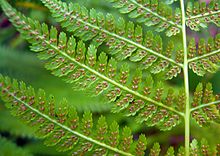Forest Lady Fern
| Forest Lady Fern | ||||||||||||
|---|---|---|---|---|---|---|---|---|---|---|---|---|

Forest lady fern ( Athyrium filix-femina ) |
||||||||||||
| Systematics | ||||||||||||
|
||||||||||||
| Scientific name | ||||||||||||
| Athyrium filix-femina | ||||||||||||
| ( L. ) Roth |
The Forest Lady Fern ( Athyrium filix-femina ), also just Frauenfarn or Common Forest Fern called, is one in Central Europe widespread fern - Art .
description
They are deciduous plants that overwinter with a short, creeping or ascending rhizome .
The fronds reach lengths between 30 cm and 1 m and are pinnate two to three times. Their main axis is usually green, sometimes straw-colored to pink. The pinnate leaflets are 2.5 to 3 times as long as they are wide. The axis and leaflets are covered on the underside, especially in youth, with small, club-shaped hairs, which can give them a somewhat floury appearance.
The sori , which are located in rows between the midrib of the leaflets and their edge, a little closer to the rib, are clearly hook-shaped at the base of the leaflet, then elongated straight above. They are covered by the indusium of the same shape until the spores are ripe . Spore ripening is from July to August.
Overall, the forest lady fern is similar to the worm fern , but can easily be distinguished by the shape of the sori. Sterile plants appear a little less coarse, and the fronds are significantly narrower at the bottom.
The number of chromosomes is 2n = XX.
ecology
The forest lady fern is a deciduous rosette plant with a storage rhizome . It forms a VA mycorrhiza .
A full-grown plant produces 20–80 million spores annually.
The species is cultivated in numerous varieties as an ornamental plant.
Toxicity
The rhizome of the forest lady's fern does not contain the poisonous filix acid like that of Dryopteris filix-mas , but it does contain other filix active ingredients, which is why it should also be particularly poisonous for lower animals.
etymology
Due to the similarity with the common worm fern , which usually has somewhat coarser and larger fronds, these two species were previously thought to be males and females. This is where both the German name "Frauenfarn" and the scientific species name filix-femina (filix = fern, femina = woman) come from.
Distribution and location requirements
The forest lady fern occurs in the entire temperate latitudes up to the subtropics of the northern hemisphere, also in Central and South America , whereby with the southern forms it is not certain whether it is not a separate species.
It grows in moist forests, especially on soils poor in lime. It is widespread in forests; but he also likes to colonize embankments, herbaceous corridors and freshly seeped wall joints. It is a shade-semi-shade plant and occurs in rainy mountains especially in Fagion societies, in dry and warm lowlands but almost only in societies of the Alno-Ulmion or moist Carpinion as a gley and pseudogley pointer. It is seldom found in the adenostyle or wet piceion. In the German Alpine region, it rises to around 1880 m above sea level.
Systematics
One can distinguish between two varieties:
- Athyrium filix-femina var. Angustum (Willd.) G. Lawson (Syn .: Athyrium angustum (Willd.) C. Presl ): It occurs in Greenland, Canada and the eastern and central United States.
- Athyrium filix-femina var. Filix-femina : It occurs in Europe, Turkey, the Caucasus and western Siberia.
Parasites
The forest lady fern sometimes shows a noticeable deformation of its fronds, which are then curled inwards. This is caused by larvae of the flower fly Chirosia betuleti .
Sources and further information
literature
- Henning Haeupler , Thomas Muer: picture atlas of the fern and flowering plants of Germany (= the fern and flowering plants of Germany. Volume 2). Published by the Federal Agency for Nature Conservation. Ulmer, Stuttgart 2000, ISBN 3-8001-3364-4 .
- Werner Rothmaler : Excursion flora for the areas of the GDR and the FRG . Volume 2: Vascular Plants, 14th Edition. People and knowledge, Berlin 1988, ISBN 3-060-12539-2
- Hans Martin Jahns : BLV identification book for ferns, mosses, lichens. BLV Verlagsgesellschaft mbH, Munich 1982, ISBN 3-405-11893-X
- Ruprecht Düll , Herfried Kutzelnigg : Pocket dictionary of plants in Germany and neighboring countries. The most common Central European species in portrait. 7th, corrected and enlarged edition. Quelle & Meyer, Wiebelsheim 2011, ISBN 978-3-494-01424-1 .
- Oskar Sebald, Siegmund Seybold, Georg Philippi (Hrsg.): The fern and flowering plants of Baden-Württemberg. Volume 1: General Part, Special Part (Pteridophyta, Spermatophyta): Lycopodiaceae to Plumbaginaceae. 2nd, supplemented edition. Eugen Ulmer, Stuttgart 1993, ISBN 3-8001-3322-9 .
Individual evidence
- ↑ a b Erich Oberdorfer : Plant-sociological excursion flora for Germany and neighboring areas . 8th edition. Stuttgart, Verlag Eugen Ulmer, 2001. Page 79. ISBN 3-8001-3131-5
- ^ A b Athyrium in the Germplasm Resources Information Network (GRIN), USDA , ARS , National Genetic Resources Program. National Germplasm Resources Laboratory, Beltsville, Maryland. Retrieved March 5, 2019.
- ↑ JCH DeMeijere: About Hymenoptera and Diptera larvae parasitizing in ferns. Tijdschrift voor Entomologie, Volume 54, 1911, pages 80-127.
Web links
- Forest Lady Fern. In: FloraWeb.de.
- Forest Lady Fern . In: BiolFlor, the database of biological-ecological characteristics of the flora of Germany.
- Profile and distribution map for Bavaria . In: Botanical Information Hub of Bavaria .
- Distribution in Switzerland [1]
- Area map of the northern hemisphere
- Thomas Meyer: Lady fern data sheet with identification key and photos at Flora-de: Flora von Deutschland (old name of the website: Flowers in Swabia )
- Athyrium filix-femina - Flora of North America


